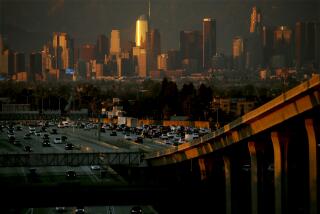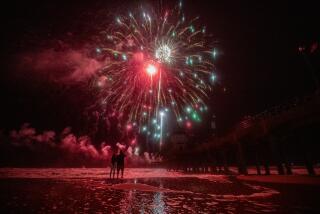Throwing cold water on the cherished tradition of beach bonfires
Before the first star appears, dozens of fires lick the sand at Dockweiler State Beach, mirroring the copper-colored sunset. This coastal strip in Playa del Rey is the last major L.A. outpost of a California rite of summer since Annette Funicello and Frankie Avalon Watusied through the “Beach Blanket Bingo” era: the beach bonfire.
Every weekend, hundreds of people stream down Imperial Highway as early as 6 a.m. to grab one of Dockweiler’s 60 fire rings, roast marshmallows and listen to the surf as the light fades away.
Bureaucrats and homeowners, however, are robbing us of this romantic legacy. Of the 108 state parks and beaches in California, only 24 allow fires, and some have early curfews. The latest assault comes from Newport Beach, where the City Council is seeking to yank dozens of fire rings from Corona del Mar State Beach and the Balboa Pier strand.
The council, in its unanimous decision, cited “health and safety” and its trusty civic sidekick, “liability.” A pulmonologist testified about the health hazards of smoke, and dire warnings were issued about children stepping on live coals.
The debate was a charade. If air quality is at stake, why not ban backyard fire pits? What about the diesel-spewing yachts that leave an oil slick on the waters of Newport Harbor?
As sympathetic as I am to the task of corralling toddlers, how hard is it to keep them out of concrete fire rings marked in block letters reading “DANGER HOT COALS”?
The real reason for the proposed ban is that some Newport residents want the beaches to themselves. It’s the same crowd that is trying to stamp out the beach town’s historic honky-tonk flavor: witness the squeeze city fathers and mothers have put on Balboa Fun Zone, the raucous playground of my youth.
No one seems to know exactly how or why it came to this. As a child, I remember my father digging a hole in the sand and setting driftwood on fire. In my teens, I flirted with boys beside roaring bonfires. But by 1990, beach fires had been banned along L.A.’s shoreline outside of designated rings at Dockweiler and Cabrillo Beach in San Pedro, supposedly because of an “explosion” in coastal visitors.
The ensuing years have seen sporadic fights over beach fires up and down the state, with the exception of Santa Cruz and San Diego counties, where, despite some skirmishes, they have kept their place as civic treasures.
Fire-friendly beaches are among the last publicly maintained spaces in California where those of us who don’t happen to own private beaches can make our own fun, the setting for countless free-form birthday parties, first kisses and offbeat holiday celebrations. The personal freedom they embody was once emblematic of the California lifestyle. Now, we are in danger of regulating them out of existence.
“It’s just very sad,” fire-ring supporter Nadine Turner said. “Newport Beach is not what it used to be. It’s turning into a country club.”
The fire rings have been there longer than most of those who want to get rid of them. While Nouveau Newport wants to put out the blazes, some old-line residents are desperate to pass the beach fire tradition on to their children.
The city’s proposal still must get by the Coastal Commission. An online petition to stop the ban has gathered more than 5,000 signatures.
“This has been a tradition for generations of my family,” Mark Nass, a signer, commented on the petition. “What is next? Should we ban Boogie Boarding because it draws unsupervised long-haired youth to the shoreline? Let’s ban flip-flops on the beach, because when you lose one they don’t bio-degrade.”
It’s no secret why fires endure at Dockweiler. Straddled by a refinery and a sewage plant, and crisscrossed by jets screaming out of LAX, it’s the least pristine beach in the L.A. Basin.
There are no homeowners around to complain that outsiders, with their clanking coolers and folding chairs, are invading their turf. Nearly 800 houses on the cliffs above Dockweiler were removed decades ago because of the airport racket.
There was a time when Dockweiler was rocked by fights and occasional gun violence. But those days are largely over. What remains is a panoramic view of the imaginative things Southern Californians do in the shrinking slice of freedom that remains to them.
One Saturday this month, a group of young people clapped and stomped around a flaming pit, singing God’s praises: “Lord, you are awesome.” Nigerian fraternity brothers in yellow berets wrapped up a reunion. Middle school teacher Darnell Jones pulled out his portable massage table to give his friend, chef Joy Scales, a birthday rubdown where she could hear the waves crash and watch the sunset.
The next weekend, Ginger Smith’s friend had a roast pig delivered to the beach for her birthday. But they forgot the knife. No problem — at a nearby fire pit, a Hawaiian carver was happy to help.
In no time, Ginger’s boyfriend, cigarette hanging off his lip, was slapping his bongo around the fire with a drummer from the other party.
“We just met these people,” she explained, as the birthday girl, dressed in a grass skirt, hulaed around the campfire.
Lamont Williams, the self-described patriarch of a sprawling family, brings his clan down every other week for what he calls a “b-o-n-d-f-i-r-e.”
“I want to show the kids something outside the neighborhood,” said Williams as assorted children bent wire hangers to roast marshmallows for s’mores.
If Newport’s fire pits go, they’re not coming back.
Annette and Frankie would be outraged. I am too.
More to Read
Start your day right
Sign up for Essential California for news, features and recommendations from the L.A. Times and beyond in your inbox six days a week.
You may occasionally receive promotional content from the Los Angeles Times.






